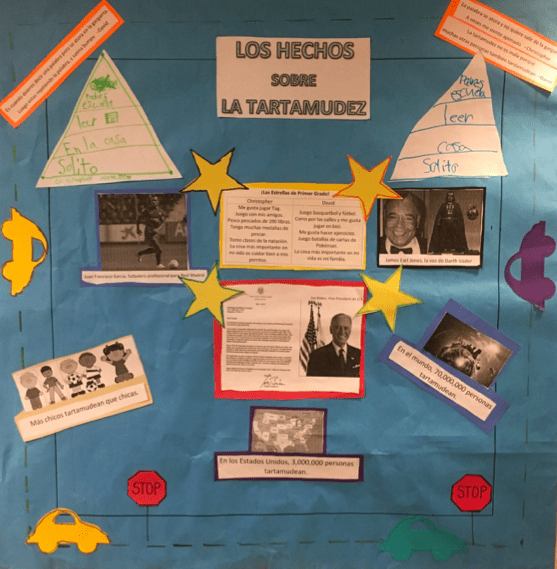
This week Maria Mitidieri shares her creative approach to fluency therapy that has helped her increase self-confidence in students who stutter.
I recently had the unique opportunity to have two students with moderate-to-severe stuttering admitted onto my caseload within a month of each other. These students were both boys of the same age and grade who had never received fluency therapy before. I believed that because they were in speech together and had so many similarities that they would accelerate through the first stages of fluency therapy.

Identifying Stuttering and the Feelings Associated With It
The students watched and listened to videos of children who stuttered so they could hear different stories and feelings about stuttering, and also practice identifying stuttering moments. Despite this exposure to other children who stutter, their self-consciousness about stuttering still appeared to limit their progress. They continued to avoid eye contact, put their hands in front of their faces, and use quiet voices when they spoke, often refusing to verbalize and take ownership of their stuttering.
As speech-language pathologists, we know that our students who stutter face particular challenges maintaining confidence in their speech, which can translate to a lower overall self confidence. Fostering a negative self-image can limit progress in speech therapy, as well as reduce motivation to interact in the classroom.
Self-Disclosure Boosts Self-Confidence in Students Who Stutter
In the case of these two first grade students, I knew that merely telling them not to feel ashamed about stuttering would not magically turn their self-perception around. Following the research on self-disclosure, which supports the idea that disclosing stuttering to others results in self-empowerment and a decrease in the vulnerability that many children feel when speaking to others (Franck, Jackson, Pimentel & Greenwood, 2003; Hartford & Leahy, 2007), I came up with a great activity to convince my students that stuttering was not their only defining trait, and to support their road to self-disclosure.
The Facts about Stuttering
The students researched stuttering, including the different types of stuttering, facts about the number of people who stutter in the world, the number of people who stutter in the United States, the ratio of boys versus girls who stutter, and lists of famous people who stutter. Based on this information, they compiled information they would want other people to know about stuttering.
The Personal Perspective
The Stars of First Grade: Each boy listed reasons why he is a star student in his class and shared things that defined him—hobbies, family, pets, and accomplishments—that far outnumbered the one fact that they stuttered.
The Poster

The boys compiled their research and information into a poster. They included their heirarchies, definitions of stuttering, facts about stuttering, and a “star” section (my favorite part). They pasted their class pictures next to those of famous actors, athletes, and politicians who they admired and learned were also people who stuttered. Under each picture, was a description of the accomplishments of each star, both of the famous ones, and of themselves. Surrounding all this information, was the poster’s border that appeared like a road, with cars stopped around the edges at stop signs.
The Presentation About Stuttering
Throughout the research and reflection process, the boys practiced identfying stuttering in themselves and others, decreasing their rate of speech, and using easy onset. After participating in this activity, which took about five weeks, the boys had gained enough confidence and ownership of their stuttering that not only were they openly talking about stuttering with me and each other, but they did not need to be convinced to present their poster to their teachers and classmates. They spent two weeks practicing their presentation in front of me, other special education teachers, the librarian, and the nurse before they finally shared to their large classes. The greatest affirmation the boys received in this entire process was the fact that following the presentation, their friends cheered and asked them questions about the poster and what they do in speech therapy.
A Boost in Self-Confidence in Students Who Stutter
The presentation not only gave the students the self-confidence they needed to overcome their shame of their stuttering, but they also received the support from their classmates to carry their newfound confidence every time they left for speech therapy—they knew their friends understood why they left class, and they no longer felt the need to try to hide their stuttering from others. As a team, they experienced their value and now truly believed in the value of their speech, and themselves as individuals.
Fluency Assessment: Tasks, Tips and Tools
As speech-language pathologists, we perform fluency assessments far less frequently than we do assessments of language or articulation. In this presentation, I’ll share some of the tasks I include in my fluency assessment, tips for analysis and goal settings, and a cool tool I created to speed up your analysis.
References
Franck, A. L., Jackson, R. A., Pimentel, J. T., & Greenwood, G. S. (2003). School-age children’s perceptions of a person who stutters. Journal of Fluency Disorders, 28(1), 1-15.
Hartford, E., & Leahy, M. M. (2007). The perceptions of primary school children of a person who stutters. In Proceedings of the 5th world congress on fluency disorders(pp. 223-229).






Great idea!
I love this idea! I currently have two first graders that stutter as well, but they are at different schools so I wouldn’t be able to have them work together, but this sounds like it would help them both! I noticed the poster is in Spanish and I also service Spanish speaking children. I would really appreciate any information you can share about where to find explanations about strategies in Spanish or anything you can share. I look forward to hearing from you.
Hi Lori,
Thanks for your comments! I just sent you a pdf of some handouts from a presentation we did in Mexico on intervention for stuttering.
Best, Ellen
Can I please get a copy of those, too? I have a hard enough time finding Spanish-language materials for language and artic., let alone fluency.
Hi Ellen,
May I please have a copy of your handouts? I have a group of 4 students who stutter.
Thank you!
Hi Dang,
This post was created by one of our SLPs, Maria Mitidieri, about work she did in the schools. There are no handouts.
I love this!
Thanks for the helpful ideas! I work with pre-k through 2nd grade and I am always looking for ways to involve students in the therapy process, especially stuttering! What resources did your students use for researching stuttering? Any thoughts on helping my youngest (pre-k) students with this?
Thanks,
Andrea
Hi, Andrea!
I had my students look up the children’s resources on the Stuttering Foundation’s website. Given the students’ ages, I guided them heavily with the location of the information on the website. But I kept everything online for them and let them pick where they wanted to go on the Stuttering Foundation’s website to empower them to choose what they wanted to include in their poster. One of the resources we used that I think would be beneficial for pre-k students was the Stuttering Foundation’s video of interviews with children who stutter, and what they thought of stuttering. Although this was in English, my Spanish-speaking students benefited from the videos because they were still able to identify/observe/hear stuttering moments, both auditory and visual (physical concomitants).
Maria
Hi there! I would love to get the handouts as well. I have a fifth grader who would benefit from this idea. Thanks!
Carol